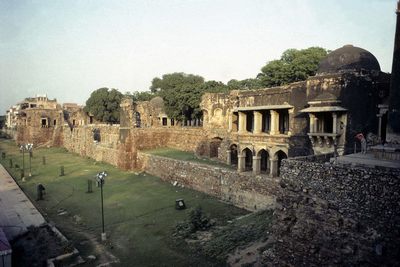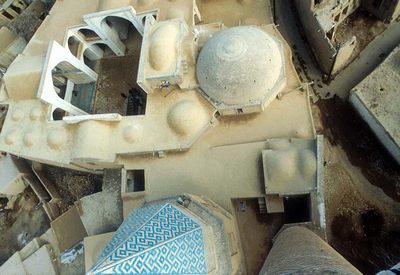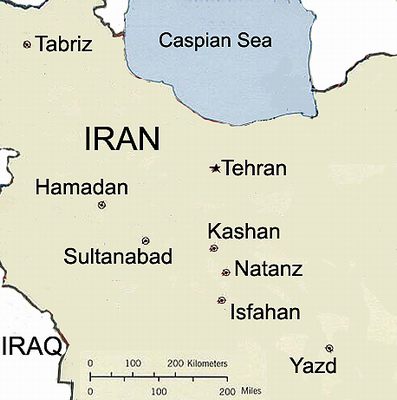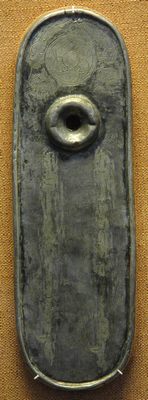East Meets West under the Mongols
Sheila S. Blair
Boston College
Fig.1. Delhi, Hawz Hass. Photograph © Sheila S.Blair. All rights reserved.
ost people think of the Mongols only as destroyers, ruthless marauders who slaughtered the inhabitants of cities resisting their military advances, barbaric conquerors who magnified the scale of violence with deadly mangonels and ratcheted up the volume of terror banging on drums as part of their psychological warfare. The Mongols, followers of the warlord Chingis [Genghis] who amassed the largest contiguous land empire ever known, were undisputedly deadly and terrifying. But the Mongol conquests in the first part of the thirteenth century also opened up a commercial nexus across Eurasia, and the century 1250-1350 when the Mongols controlled most of Eurasia is often known as the Pax Mongolica. In the words of the historian Janet Abu-Lughod, it was the age “before European hegemony,” a period when trade and communication encouraged the sharing of ideas and visual culture across much of the known world.
Following the death of Chingis Khan in 1227, his empire was divided among his family according to the principle of ultimogeniture, succession through the last-born child. Four major empires were created. The Great Khans, Möngke (r. 1251-60) and Qubilai (r. 1260- 94), descendants of Chingis’s youngest son Tolui, ruled Mongolia and northern China as the Yuan dynasty from their capitals, first at Karakorum on the upper Orkhon River in Mongolia and later at Khanbalik, now Beijing. They were supported by three collateral branches. The Golden Horde, descended from Chingis’s eldest son Jochi, ruled southern Russia from two capitals on the Akhtuba, the eastern tributary of the lower Volga, first at Old Saray, on the left bank about seventy-five miles north of Astrakhan and then from the 1340s from New Saray (Saray al-Jadid, modern Tsarev), a further seventy-five miles upstream. The Chaghatayids, descended from Chingis’s second son Chaghatai, ruled Central Asia from various capitals in Semirechye and Transoxania including the site founded by Kebek (r. 1309-26, with interruption) near Nakhshab known as Karshi (from the Mongol word for palace). The Ilkhanids, descended from Hülegü, brother of the two Great Khans, ruled western Asia from winter and summer capitals in Azerbaijan and Iraq.

Fig. 2. Natanz, Shrine of ‘Abd al-Samad, view from minaret.
Photograph © Sheila S. Blair. All rights reserved.
The transcontinental trade that took place under these various branches of
Mongols is readily evident from reports by the spate of travelers who crisscrossed
Eurasia during this period. The most famous, at least to Western eyes, is Marco
Polo, the Venetian merchant who joined his father and uncle on a trip to China
in 1271 and spent the next two decades traveling around the provinces of China
in the service of Qubilai Khan. Marco Polo’s travelogue, written after he had
returned home and was imprisoned in Genoa with Rustichello of Pisa, tells of
the amazing empire of the Great Khan, an urban civilization of dazzling riches
and prosperity. This picaresque travelogue offered an immense body of new geographical
knowledge to the West and became one of most influential books of the Middle
Ages, the foremost work in creating an intellectual climate in which Europeans
set out to explore the non-European world.

Marco Polo’s account is also a record of an amazing shopping spree. His description of Tabriz, at that time capital of the Ilkhanid domains, sums up his perspective. He begins with the industriousness of the inhabitants and their major handicrafts: many kinds of beautiful and valuable cloths of silk and gold. The city’s choice location, he notes, makes it a commercial hub for merchants from Mesopotamia, the Gulf, India, and Europe, especially as it has a great market for precious stones. It is, he specifies, a city where merchants make large profits. The locals, however, are good-for-nothing, a mixture of classes, ethnicities, and religions, including the native Muslims who are evil. He ends his description with the note that the city is surrounded by charming orchards, full of large and excellent fruits. His record of the city is thus a brief commercial prospectus.
Trade was not the only incentive to travel during this period. So was religion. If Marco Polo epitomizes the mercantile traveler, then the Moroccan globetrotter Ibn Battuta represents the religious one. In 1325, at age 21, he set off from his native Tangier (hence he is sometimes referred to as a “tangerine”) on the hajj to Mecca. He returned home only in 1349, meanwhile visiting Egypt, Syria, Persia, Iraq, East Africa, the Yemen, Anatolia, the steppes of southern Russia, Constantinople, India, the Maldives, Sumatra, and China. Whereas Marco Polo enumerates the goods available in local markets, Ibn Batutta sets out the diverse (and to his eyes, sometimes slightly scandalous) religious activities he encountered while lodging at local shrines.

Fig. 3. Natanz, Shrine of ‘Abd al-Samad, muqarnas dome over
tomb, 1307. Photograph © Sheila S. Blair. All rights reserved.
In Delhi, for example, Ibn Battuta describes the great tank known as Hawz Khass, a reservoir used to collect rainwater for drinking. It served as a gathering place for musicians. Known as Tarab-abad (the city of music), the area included an extensive bazaar, a congregational mosque, and many smaller mosques as well as forty pavilions that served as housing not only for the musicians themselves, but also for singing girls who even, to Ibn Batutta’s amazement, took part in prayers during Ramadan. The site still exists [Fig. 1], and during the next generation under the Tughlughid ruler Firuz Shah (r. 1351-77), it was incorporated into a large madrasa, or theological school. The complex comprises two long blocks of rooms perched along the east and south sides of the tank, riveted together by the founder’s tomb, a domed square. The two stories contain interlocking blocks of long, narrow pillared halls and dome chambers, with cells on the lower story for residence and more open rooms on the upper story for assembly and teaching. The reservoir has now dried up, but the area lives on as one of Delhi’s chic quarters, dotted with boutiques and secluded residences.
As Ibn Battuta’s long chronicle shows, such shrine centers were common throughout the Islamic lands. Many were centered on the tomb of a local sufi (mystic) saint. A prime example of the “little cities of God” constructed at the time of Ibn Battuta’s travels is the shrine at Natanz, twenty miles north of Isfahan on the slopes of the Karkaz Mountains in central Iran, built by an Ilkhanid vizier to commemorate the tomb of the Suhrawardi shaykh `Abd al-Samad [Map, p. 26; Fig. 2]. The complex incorporates a congregational mosque with the typical Iranian plan of four iwans and a domed chamber around a central courtyard, the mystic’s tomb surmounted by a pyramidal roof, a hospice for Sufis with a splendid tiled façade, and a soaring minaret. The somewhat higgledypiggledy arrangement of the buildings suggests that they had to be jammed into whatever land was available within the town.

Fig. 4. A paiza from the Golden
Horde. State Historical Museum,
Moscow. Photograph © Daniel
C. Waugh 2005.
Yet the inventiveness of the vaulting shows how sophisticated the builders of these local shrines were. During this period in Iran, builders shifted their attention from structure to space, developing new and ingenious methods of breaking up a long and dark tunnel vault by using a series of cross arches that are joined by transverse filler vaults. In earlier examples, the crown of the transverse vault was horizontal along its entire length, but during this period builders played with more complex methods. The south iwan in the mosque at Natanz, for example, has a ramping transverse vault in which the springing lines of the vault are not flat but curve upward and parallel the profile of the cross arches. Built in the first decade of the fourteenth century, the mosque presents the earliest extant example of the break-up of the barrel vault in the Mongol period, but contemporary buildings display similar, and soon more elaborate, methods. Such inventiveness was probably developed at constructions no longer extant in the Ilkhanid capitals in northwestern Iran and then spread southeast to central Iran and thence to Central Asia, where, under the Timurids in the late fourteenth and fifteenth centuries, builders developed the decorative possibilities of transverse vaulting by reducing the load-bearing elements and opening the room to increased light and applied decoration.
Like the vaulting, the luxury of the furnishings at Natanz bespeaks the wealth available to decorate these local shrines. The shaykh’s tomb, for example, was crowned on the interior by a stunning muqarnas, or stalactite, vault [Fig. 3, next page]. Ten tiers of muqarnas rise from the piers of the cruciform room. The first eight are composed exclusively of 45° and 90° pieces, incorporating an eightpointed star over each window. In order to culminate in a twelvepointed star at the apex, the builders ingeniously altered the system at tier nine by adding pentagonal elements on the diagonal. As light filters through the stucco grilles and flickers across the vault, it seems to revolve like the dome of heaven.
The lower surfaces of the shaykh’s tomb were once ablaze with glazed tiles, many removed by later travelers and now scattered in museums around the world. The mihrab, or niche in the wall indicating the direction of prayer toward Mecca, was adorned with a multi-piece luster ensemble, including a hood now in the Victoria and Albert Museum in London (71-1885) whose large size (82 cm) and unusual three-dimensional form make it a masterpiece of potting. The lower walls were covered with a revetment of star and cross tiles, in which monochrome turquoise crosses alternated with luster-glazed stars. This dado, in turn, was crowned by a frieze of rectangular luster tiles, decorated with texts from the Koran emboldened in bright blue on a ground of birds perching amidst foliage. At least twenty such tiles are now in museum collections, many identifiable by the headless birds, defaced by a later iconoclast [e.g. Metropolitan Museum 12.44 and British Museum OA 1122; Komaroff and Carboni 2002, p. 127, figs. 149, 150].

Fig. 5. Paiza in Hermitage Museum collection, St.
Petersburg, ZO-295. Drawing originally published in
the Trudy Vostochnogo otdeleniia
Imperatorskogo arkheologicheskogo obshchestva, Vol. 5.
Commerce and religion were not the only cause for travel in this period. So was politics, as shown by the many envoys or officials traveling on government business. To insure their safety, these officials carried a passport or conduct of safe passage known as paiza, a badge that was worn suspended from belt [Fig. 4]. According to contemporary descriptions and depictions, these passes were made of wood, silver, or gold and embellished with a gerfalcon or tiger at the top, depending on the rank and importance of the holder. The Mongols had long been insistent on the sacrosanct status of their ambassadors. The Khwarazmshah’s murder of an official envoy, for example, helped precipitate Chingis’s invasion of Transoxania. In order to facilitate communication through the vast empire, in 1234, during the reign of Ögödei, the Mongols set up an official communication system known as the yam.
Marco Polo was particularly impressed with the Mongol system of communication and left a long description of it. A system of highways radiated to all provinces from the capital at Khanbalik. Posting stations were spaced twenty-five miles apart to provide a ready supply of horses. When needed, riders, often in teams, were dispatched, each equipped with a paiza. Tightening their belts and swathing their heads, the riders set off post-haste. As they approached the next station, they sounded a horn so that fresh horses were readied and riders had only to remount and continue. In this way the envoys could cover as much as two hundred or even two hundred fifty miles per day.
Such passports had already been used under the Liao dynasty in North China (907-1125). One example made of gold inscribed in Khitan “By imperial command, expedite” was found near Chengde in Hebei province [Komaroff and Carboni 2002, p. 69, Fig. 70]. Its oblong form remained typical under the Mongols, who inscribed their paizas using a variety of languages that reflect the polyglot nature of society at this time. An early Mongol example made for the Yuan of cast iron inlaid with silver and now in the Metropolitan Museum of Art [1993.256; Komaroff and Carboni 2002, p. 69, Fig. 69] is inscribed in Phagspa— the square-boxlike script devised by the Tibetan monk Phagspa for writing Mongolian and adopted under Qubilai in the 1260s. A silver example excavated near the Dnieper in the lands of the Golden Horde, and now in the Hermitage Museum in St. Petersburg [ZO-295], is rectangular with rounded ends and a hole for a cord twothirds of the way up [Fig. 5; Komaroff and Carboni 2002, p. 38, Fig. 34]. The top part is fashioned with the stylized face of a dragon so that the hole falls between the creature’s yawning jaws. The lower part is inscribed vertically in the traditional Uighur script.

Fig. 6. Ilkhanid paiza of the vizier
Tudagha. National Museum of Iran.
Published by Abdallah Quchani,
“Pa’iza,” Mirath-i farhangi 17
(Summer 1997).
Similar passports were adopted under the Ilkhanids in Iran. One in Tehran [Fig. 6] is a silver-plated copper rectangle with a scalloped end near an attached ring. One side is decorated with a walking figure carrying a threepronged stick in his left hand and a roll in his right, perhaps indicating a written decree. The plaque is inscribed in Uighur with names of the Ilkhanid sultan Abu Sa‘id (r. 1316-35) and the petitioner, the vizier Tudagha. The passport is also stamped with the seal of a certain individual named Qutlugh Tegin.
This paiza probably represents the type of personal patent that was widely used under the Ilkhanids and deplored by their chief vizier Rashid al-Din. He lamented that by the late thirteenth century in Iran, the communication system had become corrupted and was ripe for reform. According to Rashid al-Din, everyone —from wives, princes, and camp officers to leopard keepers and equerries—thought it essential to use an envoy. The roads became clogged, the envoys rapacious, and the people resentful. Furthermore, many bandits masqueraded as envoys. As a result, real envoys were often prevented from doing their business. All these problems, says Rashid al-Din as the official spokesman who formulated the party line for the Mongols, led Sultan Ghazan (r. 1295-1304) to lay down reforms to curtail such abuses.
Such communication and travel, together with common roots of authority and prestige derived from descent from Chingis, encouraged a shared visual culture, particularly among Mongol rulers in the various empires. One example is the royal drinking cups made of gold and silver. Such cups are depicted in paintings from the Jami‘ al-tawarikh, or Compendium of Chronicles, the history of the Mongols and other rulers of the world compiled by Rashid al-Din. Large double-page scenes that once illustrated the reign of each ruler show the Mongol sovereign seated beside his consort on a throne and drinking from such a cup. No examples survive from Iran; they were probably all melted down in times of need. Excavations at New Saray, the capital of Golden Horde on the Volga, however, have uncovered numerous examples in both silver and gold. Some of these shallow cups have scalloped handles decorated with vegetal motifs. Others have dragon handles that allowed the vessel to be suspended by the loop in the dragon’s mouth [Hermitage SAR- 1625; Komaroff and Carboni 2002, p. 170, Fig. 197; see also p. 18, Figs. 11, 13].
Such shared culture also extended to more quotidian objects. The typical bowl associated with the Mongols in Iran is the type known as Sultanabad ware, after the city in western Iran on the road from Hamadan to Isfahan where many pieces were found, though no examples have been excavated there. Made of an artificial body known as frit or stonepaste, these deep conical bowls have a wide rim that overhangs both interior and exterior and are underglazepainted with birds or animals on a ground of thick foliage. Their hemispheric shape, outside decoration with a design of radiating petals, and muted greygreen color scheme connects them to Chinese ceramics, both Cizhou and Jizhou wares. Their interior decoration, such as phoenixes typically arranged in groups of three or four with long curving tail feathers that emphasize the revolving design, also reflects Chinese models, transferred through textiles and other media. Ceramics made for the Ilkhanids’ rivals in southern Russia, the Golden Horde, and excavated at New Saray show similar designs, but with stiffer drawing and a smoother shape.
Of all the works of art shared between the various branches of Mongols in this period, the most important were textiles, notably those woven with gold-wrapped thread. Known as nasij and nakh in Arabic and Persian and panni tartarici in medieval inventories, these cloths were praised and collected as far away as England: Chaucer mentions “cloth of Tartary” in his “Knight’s Tale.” From the beginning of the thirteenth century the Mongols deliberately encouraged the production of such textiles. Chingis ordered craftsmen captured in Central and West Asia sent to Karakorum, and by the time of his son Ögödei, three thousand households of weavers from Samarqand were churning out cloth of gold in Xunmalin. Three hundred households were at work in Hongzhou, west of Beijing.
Virtually all surviving examples of such cloth of gold (and there are not that many) combine Chinese and Persian motifs, but based on technical and stylistic grounds, scholars are beginning to divide them into regional groups from North China, Central Asia, and Iran. Silks woven in China under the Mongols continue many features of ones woven there earlier under the Jin. All are brocaded tabbies, or plain weaves, with designs set in widely spaced and staggered rows. In the Jin silks, the brocaded design shows an individual, asymmetrical motif that is flipped from left to right in alternate rows. Many motifs display distinctly Chinese themes like swan hunts, coiled dragons, and phoenixes soaring among clouds. Other Jin silks incorporate foreign motifs but put them in a Chinese setting. A stunning red silk in Cleveland [1991.4; Watt and Wardwell 1997, pp. 114-115; Komaroff and Carboni 2002, p. 68, Fig. 66], for example, is decorated with the djeiran, a Central Asian antelope, in a Chinese setting of foliage crowned by a sun or moon supported by clouds. When the Mongols transported weavers captured from Central Asia to China, they introduced new technical features typical of Central Asia, notably paired warps. In addition, the new weavers replaced the single asymmetrical motifs typical of Jin silks with symmetrical motifs. A bright orange-red silk in Cleveland (1994.293; Watt and Wardwell 1997, pp. 122-123), for example, contains brocaded teardrops in the shape of lotus bulbs. These symmetrical designs are sometimes framed, as in a silk in Paris that displays confronted birds set within a frame. Except for the contrasting color of the selvage warps, these silks woven in China under the Mongols display technical and stylistic features typical of Central Asia.
A second group of brocaded silks seems distinct to Central Asia or eastern Iran. These complex lampas weaves were woven on drawlooms with two sets of warps and wefts for ground and pattern, sometimes with cotton for the ground weft. They have denser all-over designs, with a patterned ground that fills the space between roundels or medallions. Motifs are set symmetrically and include typical Chinese dragons and phoenixes, but they are given twisted or writhing bodies and imbued with a vitality not seen in the Chinese models. Often these silks have a band near one end with a pseudoinscription in Arabic written in a distinctive plaited script, sometimes with animal heads on the letters.

Fig. 7. Fragment of lampas-woven textile. Silk and
gilded paper lamella both spun around a silk core and
flat-woven. The David Collection, Copenhagen
No. 40/1997. Photograph © The C. L. David Foundation
and Collection, used with permission. All rights reserved.
Perhaps the most spectacular of these Central Asia silks is a set of large tent panels, each of which measures more than two meters high. Ten are now in the Museum of Qatar and the eleventh is in the David Collection in Copenhagen [Fig. 7; Komaroff and Carboni 2002, p. 45, Fig. 42]. Lampas weaves combining tabby and twill, the textiles are remarkable for their lavish use of gold threads, both silk threads spun with gilded paper strips and flat threads of a gilded animal substrate. Each panel contains a long arched niche enclosing vertical rows of large medallions, each enclosing confronted roosters or ducks separated by a stylized tree of life, alternating with rows of smaller lobed medallions, each enclosing a coiled dragon. The background is filled with vegetal scrolls and stylized peonies and lotus flowers. At the top is a pseudo inscription in the stylized kufic script, one of the features that distinguishes this group from the Chinese examples and suggests an attribution to an Islamic land. Similarly, the coiled dragons in the lobed roundels and the birds in frames are hybrids of eastern and western models.
A third group of silks can be attributed to Iran during the Mongol period. The lynchpin for localizing this group is a silk now in the Dom- und Diocezan Museum in Vienna that is inscribed with the name and titles that the Ilkhanid sultan Abu Sa‘id assumed after 1319 [Blair and Bloom 1994, p. 21, Fig. 23]. It is a complex lampas with areas of compound weave in tan and red silk with gold wefts made of strips of gilded silver wound around a yellow silk core. The pattern is even denser than those found on Central Asian examples, with four distinct stripes. The first is a wide band filled with staggered rows of polylobed medallions and ornamental diamonds with peacocks in the interstices. Next comes a narrower band of running animals, then a wider one with writing, followed by a repeat of the narrow band with running animals. The inscription shows that this sumptuous textile belongs to the type known as tiraz, official textiles woven in state factories and inscribed with the ruler’s name. This system had been in operation since early Islamic times, for textiles were often presented to members of courts.
There are good reasons that so few of these sumptuous textiles survive from the Mongol period. There are no burial goods in the Islamic lands where bodies are supposed to be wrapped in plain white shrouds and interred beneath the ground within twentyfour hours of death. The few textiles that do survive attest to the broad network of Eurasian trade during this period. Many of the large and fine examples that have come on the art market in recent years were taken from China and Central Asia to Tibet, where they were preserved until the dissolution of monasteries after the Communist occupation in 1959. Similarly, the one inscribed with the name of Abu Sa‘id must have been discarded after the sultan’s death in 1335. He died leaving no heir or even a close relation, and the subsequent two decades were filled with chaos and squabbling as a series of ephemeral khans were raised to the throne by competing amirs. Considered worthless in its original context, the textile was probably acquired on the cheap by an Italian merchant who brought it back to Milan where he sold it to Rudolf IV, Duke of Austria and founder of the Austrian branch of the Hapsburg line who turned Vienna into the cultural and intellectual center of the Hapsburg Empire. Rudolf died suddenly from an infection in Milan in 1365, and this sumptuous silk, presumably the finest that could be acquired by this enterprising monarch who went so far as to forge documents and invent fictitious titles and privileges to enhance his personal status and the position of his family, was then sewn up into his burial garment.
This network of transcontinental communication came to an end in the middle of the fourteenth century. By 1353 squabbling and chaos had eliminated all peripheral heirs to the Ilkhanid line, and Iran was carved up among several local dynasties. In 1368 the Ming replace the Great Khans in China. Plague struck as well, for the nexus of trade and communication was also an axis of evil in the form of rats and disease. The Black Death, as it became known in European history, had begun during the early fourteenth century on the steppes, where a permanent reservoir of plague infection existed among the wild rodents of the region. The pandemic spread south and west, fostered by the easy communication of the Pax Mongolica. It first descended on China and India, then moved westward to Transoxania, Iran and finally the Crimean peninsula on the north shore of the Black Sea. From Crimean ports, merchant ships brought plague to Constantinople in mid-1347 and then to other harbors around the Mediterranean basin. Egypt was infected by the fall of 1347 and Syria by the spring of 1348. But surviving works of art bear witness to the remarkable century of global trade and communication that followed the Mongol invasions.
About the Author
Sheila Blair is the Norma Jean Calderwood University Professor of Islamic and Asian Art at Boston College, a position she shares with her husband and colleague Jonathan Bloom. She has also taught at many universities, both in the United States and abroad, most recently as a visiting professor at the École des Hautes Études en Sciences Sociales in Paris during May, 2005. Her special interests are the uses of writing and the arts of the Mongol period. Her tenth book, Islamic Calligraphy, is due out this winter from Edinburgh University Press. She may be reached at sheila.blair@bc.edu.
References
- Abu-Lughod 1989
Janet L. Abu-Lughod. Before European Hegemony: The World System A.D. 1250-1350. New York: Oxford University Press, 1989. A highly readable and stimulating interpretation of the global economic system prior to the European “Age of Discovery.” - Allsen 1997
Thomas T. Allsen. Commodity and Exchange in the Mongol Empire: a Cultural History of Islamic Textiles. Cambridge; New York: Cambridge University Press, 1997. A careful compendium of textual information on the spread of gold-embroidered textiles across Asia under the Mongols. The companion volume on other aspects of cultural exchange is his Culture and Conquest in Mongol Eurasia (Cambridge; New York: Cambridge University Press, 2001). - Blair 1986
Sheila S. Blair. The Ilkhanid Shrine Complex at Natanz, Iran. Cambridge, Mass.: Center for Middle Eastern Studies, Harvard University, 1986. Publication of the author’s 1980 Harvard Ph.D. dissertation. - Blair 2005
Sheila S. Blair. “A Mongol Envoy.” In The Iconography of Islamic Art: Studies in Honour of Robert Hillenbrand. Ed. Bernard O’Kane. Edinburgh: Edinburgh University Press, 2005, pp. 45-60. Includes a discussion of the Mongol paiza. - Blair and Bloom 1994
Sheila S. Blair and Jonathan M. Bloom. The Art and Architecture of Islam 1250-1800. New Haven and London: Yale University Press, 1994. An elegantly produced survey in the Pelican History of Art series. - Dunn 1986/2005
Ross Dunn. The Adventures of Ibn Battuta: A Muslim Traveler of the 14th Century. Berkeley etc.: University of California Press, 1986; rev. ed. 2005. Retells the globetrotter’s remarkable story to a general audience. - Ibn Battuta 1958-2000
The Travels of Ibn Battuta, A.D. 1325-1354. Tr. with revisions and notes from the Arabic text edited by C. Defrémery and B. R. Sanguinetti by H.A.R. Gibb. 5 vols. Works issued by the Hakluyt Society, 2nd ser., nos. 110, 117, 141, 178, 190. Cambridge, for the Hakluyt Society, 1958-2000. The complete text with extensive indexes and notes. Excerpts, including his observations on Tabriz and his travel in the lands of the Golden Horde, are available online “Ibn Battuta: Travels in Asia and Africa 1325-1354” http://www.fordham.edu/halsall/source/1354-ibnbattuta.html, taken from Gibb’s condensed translation first published in 1929. - Komaroff and Carboni 2002
Linda Komaroff and Stefano Carboni, eds. The Legacy of Genghis Khan: Courtly Art and Culture in West Asia, 1256-1353. New Haven and London: Yale University Press, 2002. A splendid catalogue of an even more splendid exhibition held at the Metropolitan Museum of Art and the Los Angeles Country Museum of Art in 2002-3, this is the best survey of objects from this period in West Asia. Many of the objects described above are illustrated here in glorious color. A beautifully designed introduction to the exhibit may be viewed via the Internet at http://www.lacma.org/khan/index_flash.htm. - Larner 2001
John Larner. Marco Polo and the Discovery of the World. New Haven: Yale University Press, 2001; first published 1999. Puts the traveler’s work in global perspective and provides a valuable discussion of its impact on European thinking about Asia in the Renaissance. - Polo 1903/1993
Marco Polo. The Book of Ser Marco Polo, the Venetian: Concerning the Kingdoms and Marvels of the East. Tr. and ed., with notes, by Colonel Sir Henry Yule. 2 vols. 3rd ed., rev. by Henri Cordier. London: J. Murray, 1903; reprinted by Dover, 1993. The most famous of the translations into English. See the additional volume of notes by Cordier, Ser Marco Polo; Notes and Addenda to Sir Henry Yule’s Edition, Containing the Results of Recent Research and Discovery (London: J. Murray, 1920). - Polo 1958
The Travels of Marco Polo. Tr. Ronald Latham. Harmondsworth: Penguin, 1958. - Mackintosh-Smith 2001
Tim Mackintosh-Smith. Travels with a Tangerine: A Journey in the Footnotes of Ibn Battutah. London: J. Murray, 2001. An entertaining account by a modern traveler revisiting the opening stages of the journey. - Watt and Wardwell 1998
James C.Y. Watt and Anne E. Wardwell. When Silk was Gold: Central Asian and Chinese Textiles. New York: Metropolitan Museum of Art, 1997. Another glorious catalogue from an exhibition held the Cleveland Museum of Art and the Metropolitan in 1997-98. A great many examples are from the Cleveland Museum’s outstanding textile collection and are published here for the first time. The museum’s website displays images of many items, including the two discussed above:1991.4 Brocade with Djeiran Gazing at the Moon http://www.clevelandart.org/oci/magnify/1991/1991.4.jpg .
1994.293 Brocade with Lotus Flowers http://www.clevelandart.org/oci/magnify/1994/1994.293.jpg .
